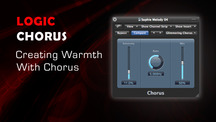In this latest Logic Pro chorus tutorial Mark Cousins investigates how use of chorus and flange plug-ins can add warmth and stereophonic width to a range of different sounds. Let’s start at the beginning..
Although we nowadays associate ‘warmth’ with something of analogue origin, it’s worth remembering that one of the most common techniques of adding tangible warmth and stereo width to a signal is good, old-fashioned chorus. Indeed, strip away the built-in chorus effects from many classic 80s string machines and you’re often left with a buzzy collection of sawtooth waves. In the plug-in world, chorus often seems to be overlooked, but when used correctly it can add a unique cinematic width to a range of sounds, from electric guitar to the aforementioned string pads. In this tutorial we’re going to explore what’s available chorus-wise in Logic Pro, from the relative simplicity of the Chorus plug-in to the Scanner Vibrato, Flanger, 12-pole Phasing and Ensemble plug-ins.
Dawn Chorus
For the purposes of this exercise we’re going to use a simple PWM synth pad sound created on the ES2. Of course, the ES2 has its own built-in Chorus, Flanger and Phaser controls, but our objective here is to explore a more controlled and versatile execution of these important ‘thickening’ effects. Of course, if you’re using a virtual instrument without these built-in chorus effects you’ll need to turn to Logic’s Modulation plug-ins as a means of creating this flattering additional warmth and movement.
View part two here.













